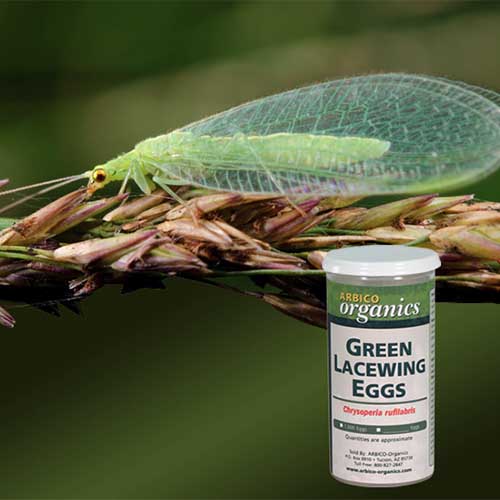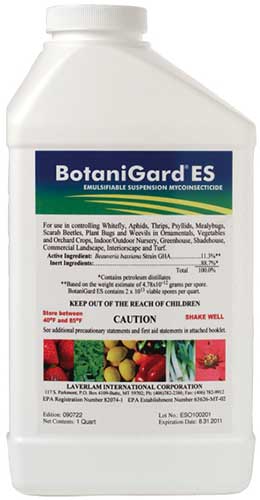Ficus benjamina
Elegant, evergreen, and fast-growing, weeping figs have become incredibly popular in warm regions. But growing these tropical treasures requires a bit of finesse.
They can falter in the wrong location, or even worse, become so robust that they destroy your plumbing – or even your neighbor’s.
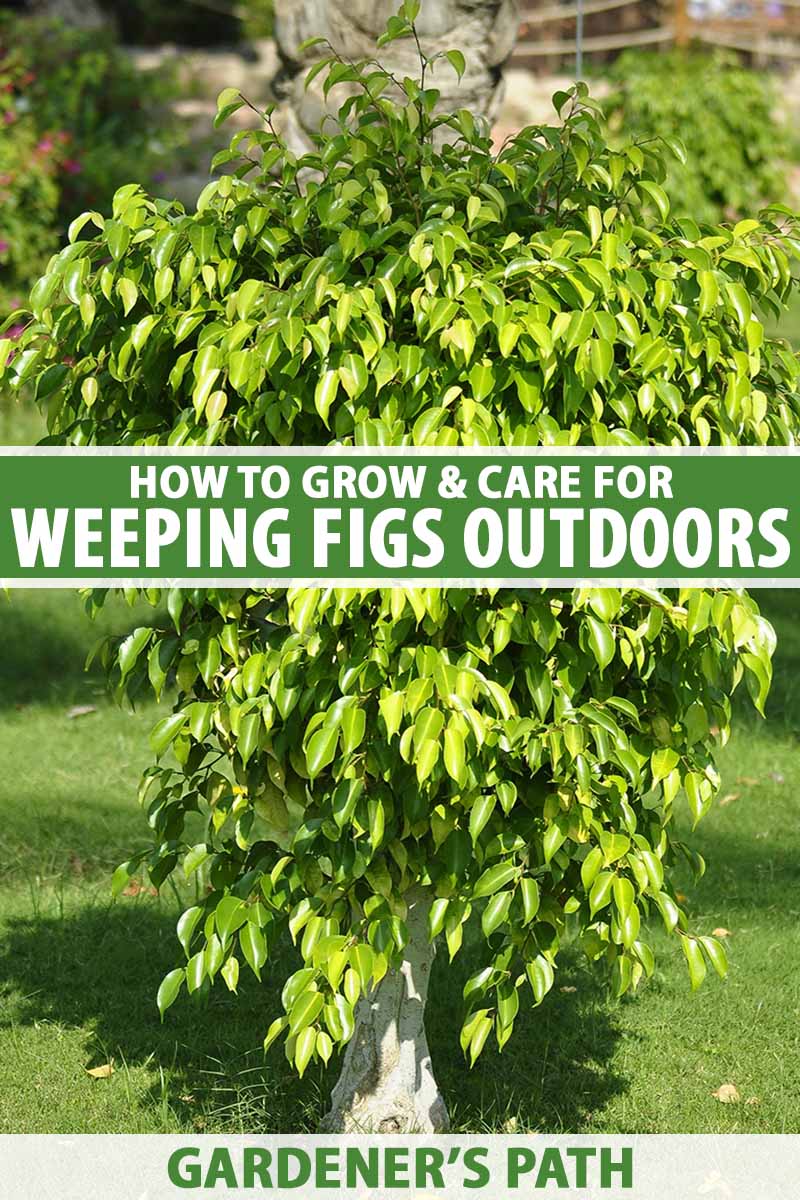
We link to vendors to help you find relevant products. If you buy from one of our links, we may earn a commission.
Whether you want to care for an existing tree or you’re interested in bringing the beauty of the Benjamin fig to your yard, a little knowledge goes a long way towards preventing heartache down the road.
Coming up, we’ll talk about how to keep your tree contained, happy, and healthy. Here’s what you can expect:
What You’ll Learn
Break out the spade, limber up, and get ready to dig in!
All About Growing Weeping Figs Outdoors
You’ve probably seen the popular Ficus benjamina growing indoors as a houseplant. It’s pretty ubiquitous in offices, malls, and homes. But it grows equally well – better, actually – outdoors in USDA Hardiness Zones 9b to 12b.
In cooler zones, plants can be grown in containers and brought indoors when the temperatures drop.
Benjamin figs don’t like to be moved, so they benefit from growing outdoors in the ground. Plopped in the earth, they won’t have to deal with the stress of moving about.
These plants have a reputation for being fussy, but that really only applies to indoor plants. Outside, it’s a different story.
Are Weeping Figs Fast-Growing Plants?
These trees can become massive outside – we’re talking up to 100 feet tall, 60 feet wide, and hundreds of feet in diameter. And they grow quickly.
While people in cold climates often turn to Lombardy poplars for fast privacy screens, those in warmer climates appreciate the quick-growing nature of the various ficus species.
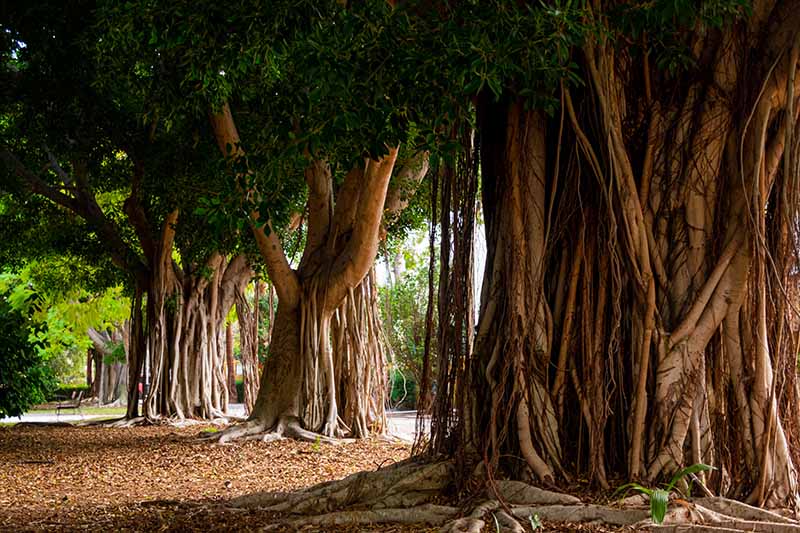
But a major problem is that they also have furiously invasive roots. Sidewalks, fencelines, and lawns are common victims of their insidious spread, and woe betide any nearby sewage lines, irrigation systems, or swimming pools.
Growing them in pots can contain the situation, keeping roots in check and their overall size more reasonable.
If you opt to grow yours in a pot that you move inside and back outdoors, know that the tree will never do as well as it would if left in one place. Each time you move it, it’s likely that some of the leaves will drop.
You’ll have to wait for new leaves to grow, but the plant will usually survive just fine, so long as not more than half of the leaves drop at one time.
But planted in the ground, you likely won’t have to deal with frequent leaf drop.
Drought stress or a cold snap might cause some leaves to fall, but you don’t have to worry about leaves raining down anytime you shift the plant a few feet to the left, like you might indoors.
To realize the benefit of both growing outdoors and in containers, plant your weeping fig in a permanent container that you won’t need to move.
Propagation
These trees can be propagated from transplants, seed, cuttings, and by air layering. For more information on each method, our guide to growing weeping figs indoors has all the details. You can also purchase seedlings or transplants.
If you live in a climate where these trees thrive, it’s likely that your local nursery has a specimen or two available. However, unless you plan to keep the tree constrained in a container on a patio or deck, don’t purchase one with a braided stem.
The braided stems are lovely on plants that stay small, but larger trees given room to grow and ideal conditions outdoors won’t do well.
How to Grow
As mentioned, weeping figs seem to have a bit of a Jekyll and Hyde situation going on. Indoors, they are mild-mannered and a little fussy. Outdoors, they can become invasive and grow extremely large.
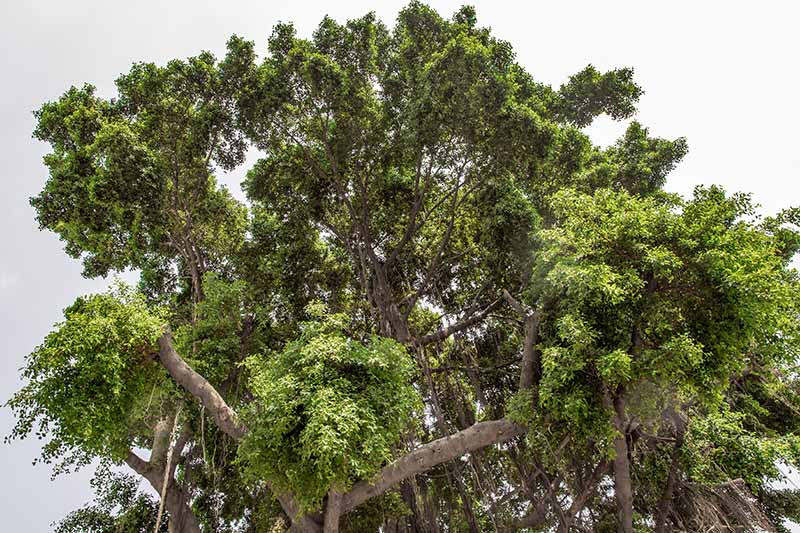
However, this depends partially on where you’re growing them. In California and Arizona, the plants tend to be better behaved.
The fruits don’t grow as large and you won’t see as many of them. The plants themselves don’t grow as large either, and they rarely spread wide and take over nearby trees.
The roots also tend to stay more contained, though they can still become invasive.
In Hawaii and Florida, however, it’s a different story.
While a lack of the right species of pollinating wasp has helped to limit the spread of these plants, the fact that so many people plant them for their fast-growing, reliable nature means they’ve become a problem in many places because of their invasive roots.
To ensure that your fig doesn’t become a huge headache, you must be careful about where you place it. Don’t put yours anywhere near concrete, plumbing, sewer lines, or swimming pools unless it is fully contained within a large planter.
You should also take care not to plant somewhere that falling fruit will be a problem. Fallen fruit can rot and make a huge mess, stain, and can create a tripping hazard. The fruits may also attract rodents like rats and mice.
How large should the container be? One that holds about 50 gallons is a good size, though you should make sure the container is on casters if you plan to move it.
Plastic, concrete, stone, or steel are ideal materials.
Alternatively, install a root barrier when you plant the tree. This involves digging a foot-deep trench just outside the anticipated drip line at maturity and filling it with a barrier material like high-density polyethylene, which should last throughout the life of the tree.
Other materials might need to be replaced as they break down.
If you decide to plant in a container, use a 50:50 mixture of compost and all-purpose garden soil. For in-ground planting, this tree prefers well-draining soil that is rich in organic matter.
That said, it’s extremely tolerant of a range of soil types, so long as whatever it’s planted in drains well.
Weeping figs also need water regularly, but they can tolerate some occasional drought.
In Florida or Hawaii, these trees rarely require supplemental water. In drier areas, you’ll need to provide additional water beyond what Mother Nature gives, particularly during times of drought.
If the top few inches of soil dry out, no matter what time of year it is, give them a good soaking.
In parts of Arizona, for instance, they will need supplemental water, and the dryness, lack of humidity, and fluctuation between heat and cold keeps them somewhat constrained.
But when temps in Phoenix dipped below freezing in 2007, the local trees suffered serious freeze damage.
If you live in Zone 9, provide them with some protection so those unexpected cold snaps don’t harm them. An area near a building where they can have south or west exposure, for instance, provides protection and additional warmth as it radiates off the building.
They also need plenty of sun. Bright sunlight for about six hours a day is about right. Any less than that and they might become leggy.
That said, if you don’t care about dense growth, they can survive in shade.
Southern Ag All Purpose Granular Fertilizer
From April through September, fertilize once a month with a 10-10-10 (NPK) granular fertilizer, like the one manufactured by Southern Ag, sold by Amazon in five-pound bags.
Growing Tips
- Plant in full or partial sun.
- Provide supplemental water in dry regions or during periods of drought.
- Contain the roots in areas where the plants grow aggressively.
- Fertilize once a month during the spring and summer.
Pruning and Maintenance
Indoors, F. benjamina rarely receives the kind of light and humidity that it prefers, and as a result, you will rarely see fruits or aerial roots. Growing these plants outdoors is another matter entirely.
Falling Fruit
The fruits are usually sterile, as well as technically being edible, but they don’t taste very good. You can leave them on the tree for wild animals to enjoy, but know that when they fall, they make a ridiculous mess.
This is no big deal if the tree is growing off in a field somewhere, but if you planted it near a sidewalk or driveway, you might want to try to pull as many of the fruits as possible once they start dropping. You could even put a tarp down to catch the falling fruits.
Of course, once the tree reaches 100 feet, pulling the fruit becomes impossible. You can clean them up off the ground using a rake or shovel.
Depending on your climate, the trees will generally fruit in the late winter or early spring and again in the early fall.
Constraining the Roots
The adventitious roots can become a problem because they will raise sidewalks and crack concrete. Adventitious roots are the ones that form above the root ball.
These are the roots that you see popping up out of the soil and bullying your sidewalk.

If this starts to happen, use an air compressor or a strong blast of water from a power washer or hose attachment to remove the soil from around the top of the root structure at the base of the trunk.
Use a saw, loppers, pruners, or all three as needed to cut away the offending roots.
Don’t be shy when you prune. I promise you, the risk of harming a tree that is established enough to destroy concrete is hardy enough to withstand some severe pruning. When you’re done, cover the roots again with soil.
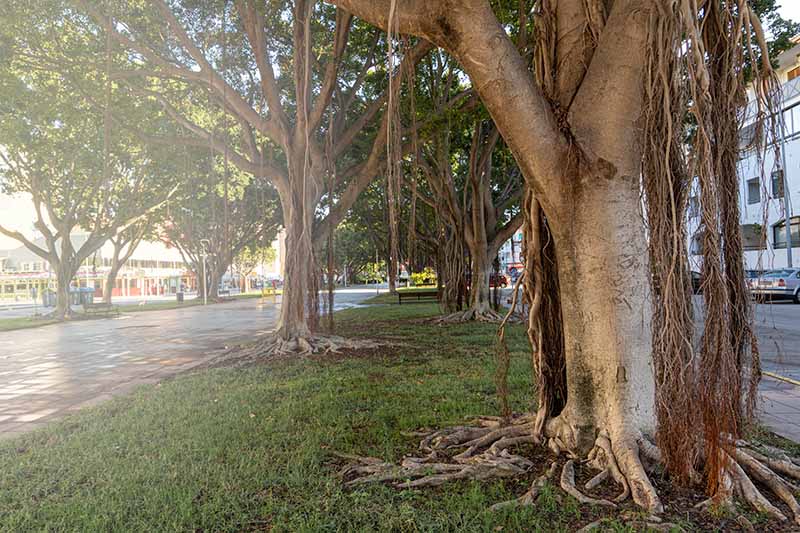
Aerial roots emerging from higher up on the tree can be left in place unless you dislike their appearance, or they start to grow somewhere that you don’t want them.
If you leave the aerial roots in place, they can become massive and even form into trunks themselves. They will drop down from branches and form new trunks, allowing the tree to spread laterally for hundreds of feet.
Pruning
Note that this tree, like most in the Ficus genus, exudes a latex when cut that can be irritating to the skin. People with a latex allergy are particularly susceptible.
Always be sure to wear gloves and long sleeves when working with these plants.
You should prune this plant regularly. Indoors, pruning is a delicate affair, but outside, feel free to go to town. Weeping figs can tolerate heavy pruning and you can even shear them to encourage dense growth, or to shape them into a topiary or a hedge.
When the tree is young, you might need to prune away the lower branches to encourage more of a standard shape.

Depending on where you are growing your tree, the required pruning maintenance will range from minimal to extreme. In California or Arizona, your biggest job will be routine annual pruning to maintain a nice shape or remove any deadwood, which may only be required every few years or so.
In tropical climates with lots of humidity and the right soil, pruning the canopy is the least of your concerns. It’s the roots that you need to watch for.
If you’ve opted to grow the tree as a hedge or topiary, you will need to shape it at least once a year, or possibly more often. This tree responds well to shearing, so make it a part of your spring and fall garden maintenance routine.
Find more tips on pruning ficus trees here.
Cultivars to Select
Our guide to growing weeping figs indoors offers more information about several different cultivars of weeping figs, but it’s important to know that any variety of “indoor” weeping fig can also be grown outside in a suitable climate.
However, some cultivars lend themselves to outdoor growing better than others. You’ll find a few suggestions below.
Most standard-sized trees will grow between 30 and 100 feet tall depending on the environment, unless otherwise noted.
Remember, you should not buy a plant with a braided stem if you plan to grow this plant outdoors unless you are keeping it contained on a patio or similar location with a solid floor.
Bushy King
‘Bushy King’ is an excellent option if you want a tree that will stay small, under about 14 feet tall. The compact growth habit combined with the overall size also makes this cultivar perfect for topiary.
Indigo
Most weeping figs sport medium-green leaves, but the foliage on ‘Indigo’ is a much deeper, darker green with faint splashes of lighter green. It can grow happily in less light than other varieties, though it still prefers partial sun to partial shade.
Golden Monique
‘Golden Monique’ has leaves with a rippled margin, and golden and green leaves that start out lime green when they’re young. This cultivar should only be grown outdoors in Zone 10 and up because it is less hardy than other types.
Margarita
The leaves on ‘Margarita’ bring to mind a warm tropical afternoon with a good drink in hand. They’re cheery yellow and lime green, with splotches of darker green throughout the centers.
Monique
‘Monique’ is similar to ‘Golden Monique,’ but it has narrow, rippling leaves with a dark green color. It is also slightly more delicate than many others, only suitable for growing outdoors in Zones 10 and 11.
Natasja
This is a classic-looking cultivar with glossy, medium-green leaves and an arching, compact growth habit.
Pandora
Lovely ‘Pandora’ has intensely curved leaves that arch so far back on themselves that the tips can touch the undersides of the leaves.
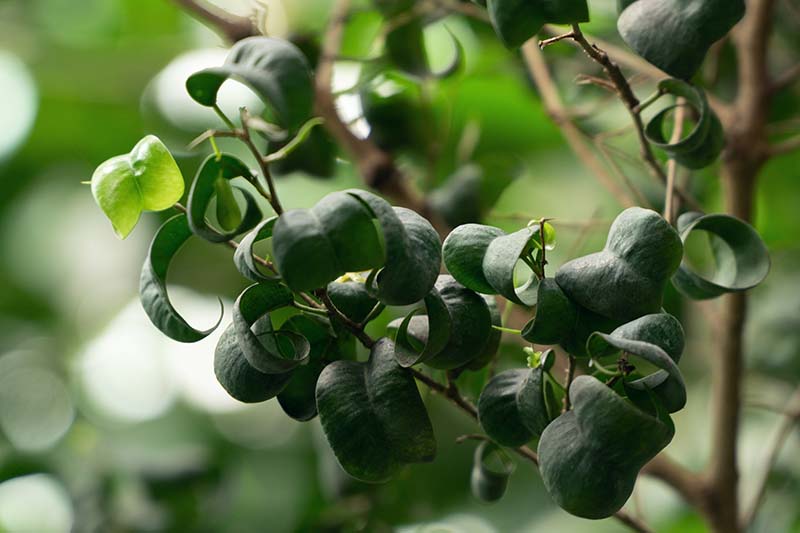
The growth habit of this variety is particularly dense.
Starlight
For a variegated variety that seems to sparkle, ‘Starlight’ is the perfect choice. The margins of the leaves are creamy yellow, while the centers are medium green.
Managing Pests and Disease
Once these trees become large and well-established, nothing much bothers them. But those that are constrained through shearing and pruning are more susceptible to problems, as are young trees.
Herbivores
Fortunately, deer don’t seem to be interested in this pretty plant.
Birds will devour the fruits, but since humans don’t enjoy them, this isn’t a problem. In fact, it might be a positive thing, depending on how you look at it. More birds mean fewer pests in the rest of your garden too.
Rabbits
Rabbits like to eat the leaves that they can reach, so they’re really only a problem when the trees are young. Once they mature a bit, a little nibble here and there doesn’t do any real damage.
To protect young trees, cover them with mesh or enclose them in fencing. Our guide to protecting plants from rabbits has more information.
Insects
The types of insects that attack weeping figs outdoors are totally different than the ones that may bother indoor plants.
Depending on the severity of an infestation, the problem can range from completely ignorable to deadly.
Psyllid Flies
There are two species of psyllids that may attack F. benjamina. These are the ficus leaf rolling psyllid (FLRP) Trioza brevigenae and the curtain fig psyllid Macrohomotoma gladiata.
The first roll up the leaves of ficus plants to make little nests inside, while the latter lay eggs at the base of young leaves, causing deformed growth and covering the leaves in a waxy secretion that attracts sooty mold.
Colonies of the curtain psyllid look like big, cottony white tufts among the leaves. The FLRP is most readily identifiable by the rolled-up leaves, though you can unroll them and look inside to be certain that’s what you’re dealing with.
In both cases, any rolled-up leaves will eventually drop from the tree.
Pirate bugs and lacewings are both natural enemies of these pests, so if you don’t have them in abundance already, it can pay off to purchase and release some in your yard.
Arbico Organics carries eggs, larvae, and adult lacewings.
Adults are best if you’re trying to introduce populations to your entire yard, but eggs are better for our purposes here. You can pick up the eggs in containers ranging from 1,000 to 250,000.
Then, spray down the tree and sprinkle the eggs and bran that they’re packaged in on the foliage, trying to cover as much of the tree as possible.
A treatment using a product containing the beneficial fungus Beauveria bassiana can also help.
Our friends at Arbico Organics have a product called BotaniGard ES in quart- or gallon-size containers that can be sprayed on your plants to control these pests whenever they are present.
Thrips
Weeping ficus thrips (Gynaikothrips uzeli) are fairly new to the US, but they are making an impact on the weeping figs here.
So far, this pest has primarily been seen in Florida, but it has also popped up in Texas, California, Puerto Rico, and Hawaii.
Damage starts appearing in the spring, when the thrips start rolling up the edges of the trees’ leaves, making them somewhat resemble a pea pod. The leaves may drop, especially in heavy rain or wind, and they may show some brown spotting.
The adults are dark brown or black and about three millimeters long. They usually only attack younger leaves.
Unless you have a very heavy infestation and your plant is young, you shouldn’t have to worry. The damage is just cosmetic in the case of mature plants.
But thrips can also bite humans, so you don’t want them to be hanging out, even if you don’t mind the damage to your tree.
Big-eyed bugs, damsel bugs, green lacewing larvae, ladybugs, parasitic wasps, and predatory mites all love to make a meal out of thrips. Neem oil or products containing B. bassiana work to eradicate this pest as well.
Learn more about how to deal with thrips in our guide.
Whiteflies
Whiteflies (Singhiella simplex) use their piercing mouthparts to stab and suck the juices out of plant tissue.
These tiny invertebrates are a serious problem for weeping figs in Florida, and plants are often completely defoliated by the pests in just a matter of weeks.
The first sign of a problem is usually yellowing leaves. Eventually, the leaves drop off and this can leave an entire tree bare. When you walk by an infested tree, you might notice little clouds of tiny insects buzzing around in the air.
If you look at the underside of a leaf, you’ll often see little white spots, which are the molted exoskeletons of immature whiteflies.
Neem oil or insecticidal sprays are typically used as the first line of attack for smaller plants. Spray once a week, and be absolutely sure to get the undersides of the leaves as well as the tops.
Carbaryl, permethrin, or pyrethrum sprays can also be used, but these can harm beneficial insects and are toxic to humans, as well.
For a large tree, using a foliar spray isn’t feasible.
Instead, you’ll need to use a soil drench containing dinotefuran or imidacloprid, such as Bayer Advanced Tree and Shrub Protect and Feed, which you can pick up in 32-ounce containers of concentrate at Amazon.

Bayer Advanced Tree and Shrub Protect and Feed
However, both dinotefuran and imidacloprid have their drawbacks. The first is mildly toxic to bees and humans, while the latter is banned in the European Union because of the harm it causes honeybees.
While we’re on the subject, it’s worth keeping in mind that whiteflies are the biggest pest of weeping figs in Florida, to the point where people have started tearing out their plants so they don’t have to continually reapply these toxic chemicals to their plants.
It’s worth talking to the reps at your local extension office to determine if whiteflies are a serious problem in your area, and whether you’re willing to deal with an infestation should it occur.
At any rate, don’t give up on your plant even if it loses every single one of its leaves. As long as the trunk and stems are alive, new foliage will form.
Weeping figs drop their leaves readily as the result of stress, but it doesn’t necessarily mean they’re toast. Give the tree up to a month to start sending out new growth before you start worrying.
Learn more about how to deal with a whitefly infestation in our guide.
Disease
You’re far more likely to run into pest problems than diseases, but that doesn’t mean you can let your guard down completely.
Bacterial Leaf Spot
Bacterial leaf spot is a disease caused by the pathogen Xanthomonas campestris. The first sign that your plant is infected is small, angular, yellow spots on the foliage. Eventually, these spots merge and the infected leaf turns brown and falls.
It’s spread by water, so ensuring that you water at the soil level can help to limit spread. Once your plant is infected, there’s nothing you can do. It’s best to pull it and dispose of it. Don’t plant anything in the Ficus genus in the area for at least a year after removal.
Phomopsis
This disease is fungal in nature, caused by pathogens in the Phomopsis genus.
At first, you’ll see leaves turning brown and dropping off the tree, which can look like any number of diseases, pests, or problems. But as the disease progresses, the branches start to die off as well. If you peel away the bark on the tree, you’ll notice that the wood underneath is black.
This disease won’t typically kill an entire plant, especially a large tree, but it can be unsightly and it spreads easily.
To deal with it, trim away all infected branches using a clean pair of clippers. Speaking of, you should always be sure to clean your tools in between using them, because that’s often how this disease spreads.
Best Uses
Weeping figs can be trained into hedges or topiaries. They also make fantastic landscape trees, or accents for a patio or deck when planted in containers.
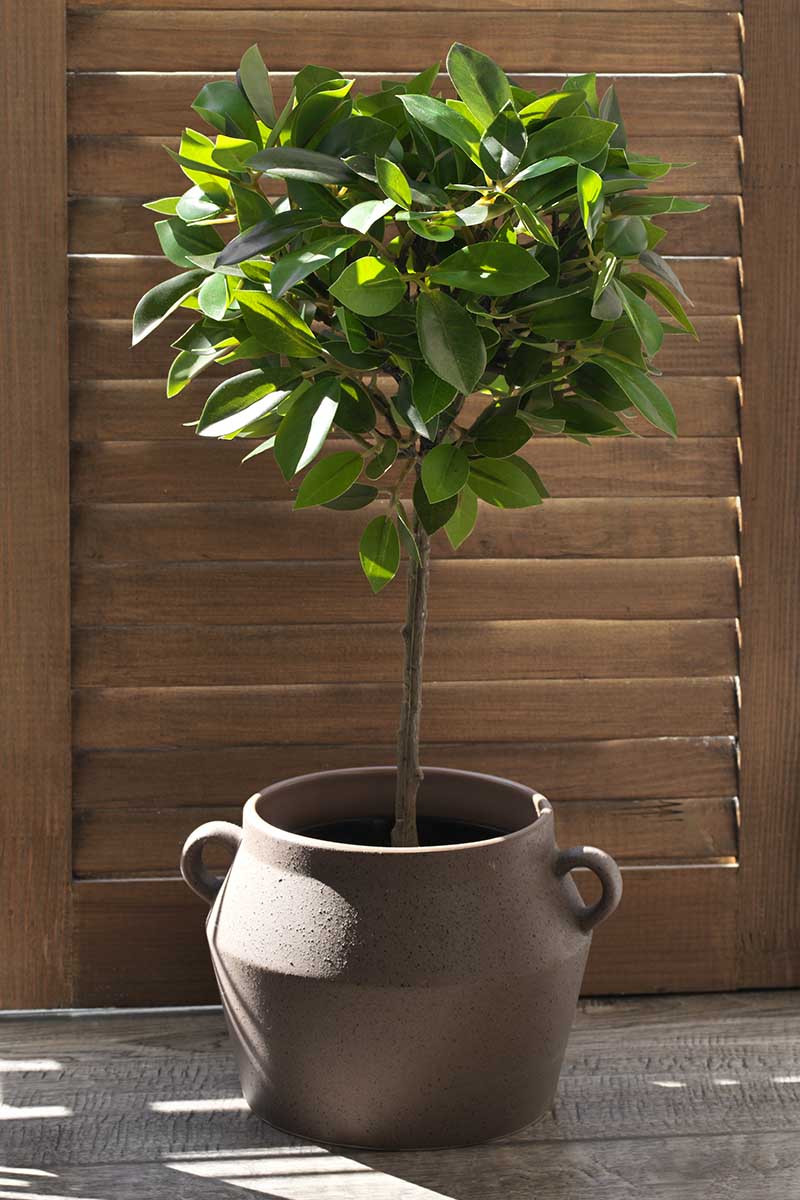
The roots can become extremely problematic in some areas, as we’ve mentioned, so you need to be conscious of where you’re planting them.
You don’t want to have to explain to a neighbor why your ficus is sticking its roots into their swimming pool.
Also, don’t make the mistake of planting this tree near an entryway.
I know they look cute in their small containers when you first purchase them, and they certainly stay manageable in terms of size if you grow them inside your home or in a pot.
But a weeping ficus will quickly become unruly when it’s in the earth outdoors, and you will find yourself needing to rip it out after a few years if you plant it in the wrong place.
Quick Reference Growing Guide
| Plant Type: | Evergreen tree | Foliage Color: | Green, yellow, white, variegated |
| Native to: | Australia, India, China, Malaysia, southeast Asia, French Polynesia, Vanuatu | Tolerance: | Moderate drought, shade |
| Hardiness (USDA Zone): | 9-12, depending on variety | Maintenance: | Moderate |
| Exposure: | Full or partial sun | Soil Type: | Garden soil amended with compost |
| Time to Maturity: | 10 years (indoors) | Soil pH: | 6.0-6.5 |
| Planting Depth: | 1/2 inch for seeds, same depth as growing container for transplants | Soil Drainage: | Well-draining |
| Height: | Up to 100 feet | Uses: | Container specimen, landscape tree |
| Spread: | Up to 60 feet | Order: | Rosales |
| Growth Rate: | Fast | Family: | Moraceae |
| Water Needs: | Moderate | Genus: | Ficus |
| Common Pests and Disease: | Aphids, foliar nematodes, mealybugs, psyllid flies, scale; spider mites; thrips, whiteflies; Bacterial leaf spot, phomopsis | Species: | Benjamina |
Make Sure Your Weeping Fig Brings Tears of Joy
In the right location, these evergreen beauties can bring year-round interest without much fuss.
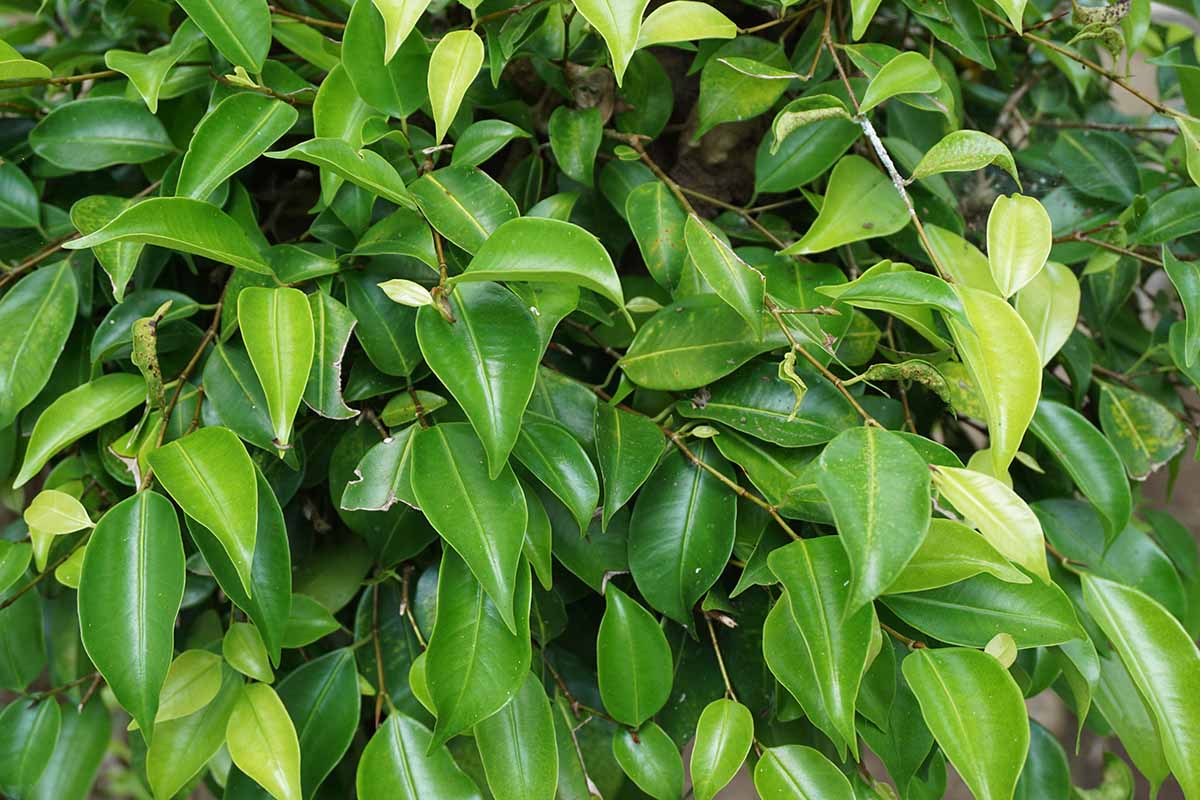
How are you growing your weeping fig? As a hedge, or maybe a tree at the back of your property? Let us know in the comments section below.
Want to add more tree goodness to your yard? If you found this guide helpful, you might be interested in exploring one (or more!) of the following guides:
